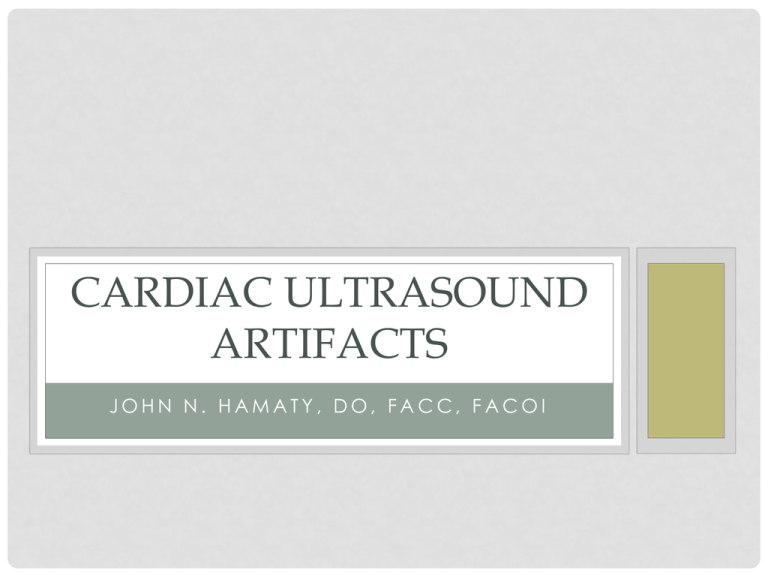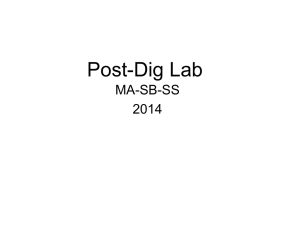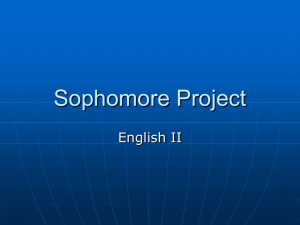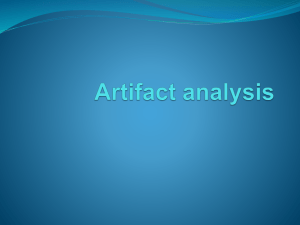Cardiac ultrasound artifacts
advertisement

CARDIAC ULTRASOUND ARTIFACTS JOHN N. HAMATY, DO, FACC, FACOI QUESTION 1 Which of the following fundamental principles of echocardiography is assumed to be correct when interpreting an ultrasound image? A. All reflections are received from each pulse after the next pulse is sent B. The distance to the reflecting object is inversely proportional to the round-trip travel time C. The sound emitted by the transducer travels in straight lines D. Sound travels in tissue at a speed of 900 m/sec ANSWER 1: C Echocardiography is a diagnostic ultrasound test use to evaluate cardiac anatomy and physiology. AS such, it is based on the physical principles of sound which travels through a medium in the form of a propagating wave. There are several assumptions behind the concept of ultrasound imagine that apply to echocardiography, and the violation of any of these can result in artifact. Artifacts are images that are not real; located in the wrong place; have an inappropriate brightness, shape, or size; or represent structures that are missing. Basic assumptions of ultrasound include the following: The ultrasonic wave emitted by the ultrasound probe travels along a straight line path to and from the transducer and makes only one path forward and back. All the echoes that are detected along that straight line originate from the axis of the main beam only. All reflections are received from each pulse before the next pulse is sent. Sound travels in tissue at a speed of 1540 m/sec. The distance to the reflecting object is determined by the elapsed time between the transmitted pulse and the detected echo. This distance is proportional to the round trip travel time. The amplitude of returning echoes is related to the reflecting or scattering properties of distance objects. QUESTION 2 Linear artifacts within the ascending aorta: A. Produce interruption of the pattern of blood in the ascending aorta when color Doppler imaging is applied B. May extend through the aortic wall C. Display rapid oscillatory movement D. Usually have clearly defined borders ANSWER 2: B Clinically, it is essential to be able to distinguish artifacts from an intimal flap associate with an aortic dissection. The utilization of criteria to define artifacts in this scenario has been shown to improve the specificity of transesophageal echocardiography in the diagnosis of aortic dissection. Linear artifacts within the ascending aorta usually lack rapid oscillatory movements, which are usually associate with intimal flaps. They also may extend: through” the aortic wall or beyond normal anatomic borders and have fuzzy and indistinct boundaries. When applying color Doppler, artifacts usually do not produce interruption in the pattern of blood flow as would be seen with the presence of a true and false lumen. QUESTION 3 Which of the following statements regarding the development of ascending aorta artifacts during transesophageal echocardiography is correct? A. Linear artifacts within the ascending aorta are most commonly caused by ultrasound refraction B. Artifacts are more likely to appear when the aortic diameter is smaller than the left atrial diameter C. A linear structure located at half the distance from the transducer as from the anterior aortic wall is most likely an artifact D. M-mode echocardiography has proven to be useful in distinguishing artifacts from true aortic flaps ANSWER 3: D There is in vivo and in vitro evidence to support that linear artifacts w9ithin the ascending aorta are caused by ultrasound reflection. In their classic experiment, Appelbe and collaborators introduced two balloons placed in series: a posterior “left atrial balloon” and an anterior “aortic balloon.” They observed that a liner image was consistently present within the aortic balloon when its diameter exceeded the diameter of the left atrial balloon, and since these contained only water, the image was by definition an artifact. Artifacts are more like to appear when the aortic diameter exceeds the left atrial diameter. Evangelista et al described the utility of M-mode applied during transesophageal echocardiography in recogn9ozing artifacts as they evaluated 132 patients with suspected aortic dissection. A type A artifact within the ascending aorta was defined as that located twice as far from the transducer as from the posterior aortic wall as seen in Figure 2.11A ( T= transducer; LA = Left Atrium; AA= Ascending Aorta.) By using M-mode echocardiography they were also able to show the unrelated motion of intimal flaps to the posterior aortic wall. Artifacts usually move parallel to the posterior aortic wall. A type B artifact is located at twice the distance from the right pulmonary artery posterior wall as from the posterior aortic wall (Figure 2-11B.) (RPA = right pulmonary artery; AA = ascending aorta QUESTION 4 Which of the following statements regarding reverberation-type artifact is correct? A. Multiple path artifacts are the result of reverberations between weakly reflective surfaces B. The larger the impedance mismatch between media, the higher the likelihood of reflections to occur. C. Interfaces oriented parallel to the direction of sound propagation have the highest probability of creating reflections D. The intensity of the reverberation lines increases as the distance from the transducer increases E. Reverberations cannot be eliminated from the field of view ANSWER 4: B When an ultrasound beam meets the interface between two different media, part of it s reflected and part of it continues into the second medium. The amount of energy reflected is proportional to the difference in acoustic impedance of the two media: the larger the impedance mismatch between the media (myocardium-air) the higher the chance that multiple reflections will develop. This is also more likely to occur when the interface is originated perpendicular to the direction of propagation. When this strongly reflected echo created at the interface returns to the transducer, some of its energy is redirected back into the patient and it can be reflected again at the same interface. This second echo returns to the transducer at a later time, and the image will be displayed farther away from the real structure since it is assumed to have arisen from a greater depth. Multiple reflections may occur when several interfaces are present for reflection, such as is the case of a mechanical valve disc. The intensity of the reverberation lines decreases as the distance from the transducer increases. M-mode echocardiography can help recognize the lack of independent motion of reverberation artifacts. Reverberations an be reduced or eliminated by changing the frequency of depth of the transducer. See figure 2.12 with two examples of how reverberation artifacts are created. (T= transmitted pulse; R = reflected pulse; L = returned pulse QUESTION 5 Which of the following statements regarding tissue harmonic imaging is correct? A. A significant proportion of harmonics is produced by side lobes B. Artifacts are more common to develop with harmonic imaging than with fundamental imaging C. Tissue harmonic signals pass only through the body wall one time D. Reverberation artifacts are more common to develop with harmonic imaging ANSWER 5: C Tissue harmonic signals pass through the body wall only one time. In fundamental imaging, the ultrasound beam passes through the body wall first when emitted from the transducer and a second time upon its return. Harmonic signals are generated in the tissue from within the body, beyond the body wall, which leads to a reduction in distortion and scattering. The transmitted wave is a fundamental ultrasound signal and the return ultrasound wave is a harmonic signal. Side lobes are weaker pulses when compared to the main ultrasound beam. These weaker pulses generated by fundamental imaging produce little or no harmonics. Side lobe artifacts and reverberations are less likely to develop with harmonic imaging. QUESTION 6 Which of the following statements regarding the development of beamwidth artifacts is correct? A. The lateral resolution diminishes as the depth decreases B. The ultrasound beam reaches its narrowest diameter in the focal zone C. Focusing can increase the chance of development of beam-width artifacts D. A beam-width artifact can make real structures, such as struts on a prosthetic valve, look smaller than the actual size ANSWER 6: B A focused ultrasound beam emitted by a transducer has a near field (proximal area to the transducer), focal zone and far field (distal area to the transducer). In the focal zone (not the far field), the beam width of the ultrasound is decreased as it reaches its minimum diameter. In the far zone, the beam width becomes wider, and the lateral resolution degrades (lateral resolution diminishes as the depth increases). When the lateral resolution from a specific region is reduced, a beamwidth type of artifact can appear, leading to an alteration in the size or shape of a structure. For example, struts on a prosthetic valve can look longer than the actual size. Beam-with artifacts can also simulate valvular vegetations. Focusing narrows the beam width and the lateral resolution improves, hence reducing the possibility of developing a beam width artifact. QUESTION 7 Which of the following statements regarding artifacts within the ascending aorta is correct? A. The utilization of M-Mode echocardiography has been shown to increase the false-positive diagnosis of an ascending aorta dissection B. Artifacts within the ascending aorta are less likely to appear when the aortic diameter exceeds the left atrial diameter C. Linear artifacts are usually found at half the distance between the transducer and the atrial-aortic interface D. Artifacts within the ascending aorta are more likely to move with the less amplitude as the aortic wall E. An ascending aorta diameter of >5 cm along with an atrial aortic ratio of ≤0.6 are important determinants of artifact appearance ANSWER 7: E Losi and collaborators found that an ascending aorta diameter of >5 cm was a detriment of artifact appearance (sensitivity of 91%, specificity of 86%). However, some patients with a normal aorta diameter can have artifacts and some with a dilated aorta may not. By adding an atrial / aorta ratio of ≤ 0.6 to an aortic size of >5 cm, the specificity and positive predictive valve for the diagnosis of an aortic artifact when an aortic dissection was suspected became 100%. M-mode echocardiography can reduce the false-positive diagnosis of an ascending aorta dissection. In vitro and in vivo evidence has shown that linear artifacts within the ascending aorta are usually found at twice the distance between the transducer and the atrial-aortic interface and are more likely to appear when the aortic diameter is twice seen at twice the distance but also move with twice the amplitude as the interface. QUESTION 8 Which of the following statements regarding the side lobe artifacts is correct? A. Side lobe artifacts involve the presence of a weakly reflective object which is close to the central beam of ultrasound B. In a side beam artifact, an image will appear at the wrong location but in the same direction of the main beam C. Side lobe artifacts are created echoes are returned from highly reflective objects located within the pathway of the central (main) beam D. All the energy emitted from an ultrasound transducer remains within the central (main) beam ANSWER 8: B The ultrasound waves emitted by the transducer travel in straight lines. Most of the energy is concentrated along a main or central beam. However, not all the energy remains within this central beam. Some of the energy is also directed to the sides of the central beam, which can produce echoes that will return to the transducer. The machine assumes that these echoes originate from points along the central or main beam axis, and the image will be displayed within this central beam. In a side lobe artifact, an image will appear in the wrong location but in the same direction of the main beam. In essence, this is a form of beam width artifact. QUESTION 9 Which of the following statements regarding a refraction type of artifact is correct? A. Refraction develops when the ultrasound beam is completely reflected B. Two different media with the same propagation speed create a refraction with the same propagation speed create a refraction type of artifact. C. Refraction can cause the appearance of a double image (side by side) D. D. Refraction makes structures appear closer to the transducer ANSWER 9: C Refraction is produced when the transmitted ultrasound beam is deviated from its straight path (change in the angle of incidence) as it crosses the boundary between two media with different propagation velocities. In other words, the sound beam bends and causes an artifact displaying a “duplicated” structure. The refracted beam is reflected back to the transducer, and this signal is assumed to be along the original scan line, leading to an image being displayed in the wrong location. In essence, refraction leads to the lateral displacement of structures from their correct location. See Figure 2.13 (T=transmitted pulse; L= returned pulse; T’ = transmitted and refracted pulse; L’= returned refracted pulse.) QUESTION 10 Which of the following statements regarding range ambiguity is true? A. Range ambiguity occurs when echoes from deep structures created by a first pulse arrive at the transducer before the second pulse has been emitted. B. Range ambiguity occurs when echoes from deep structures created by a first pulse arrive at the transducer after the second pulse has been emitted C. The pulse repetition frequency (PRF) is not affected by the imaging depth D. To avoid range ambiguity, PRF is increased when scanning deep structures ANSWER 10: B The correct imaging of deep structures is determined by the pulse repetition frequency (PRF). PRF is related to the depth of view. As imaging depth increases, PRF decreases. In order to avoid range ambiguity, the PRF is reduced when scanning deeper structures, allowing the impulse to return to the transducer on time before the next pulse is emitted. Range ambiguity can lead to the incorrect placement of structures closer to the transducer than their actual location. QUESTION 11 Which of the following statements regarding mirror-imaging artifact in spectral Doppler echocardiography is correct? A. It is usually appears when the Doppler gains are set too low B. It consists in the development of a symmetric spectral image on the opposite side of the baseline from the true signal C. The mirror image is usually more intense but otherwise very similar to the true signal D. It can be reduced by increasing the power output and better alignment of the Doppler beam with the flow direction ANSWER 11: B The mirror-image artifact (also known as cross talk) in spectral Doppler echocardiography appears as a symmetric signal of usually less intensity than the true flow signal in the opposite side of the baseline. The spectral mirror image occurs when the Doppler gains are set too high and it can be reduced by decreasing the power output or gain. QUESTION 12 Which of the following techniques can help distinguish a left ventricular thrombus from an artifact (near-field clutter). A. Increasing the depth B. Increasing the transducer frequency C. Using a single view D. Increasing the mechanical index ANSWER 12: B Left ventricular thrombus develops almost exclusively in the region of a wall motion abnormality, seen most commonly seen in an akinetic, dyskinetic or aneurysmal segment, usually at the apex. It is usually laminar, with discrete shape and borders and may appear as protruding or mobile. Its motion is concordant with the left ventricular wall. Increasing the transducer frequency, decreasing the depth, using multiple views, or utilizing the contrast agents can all help distinguish a left ventricular thrombus from an artifact (Table 2-1). The mechanical index should be decreased when using contrast to avoid excessive destruction of the bubbles. TABLE 2-1 Differential of Structures / Artifacts in the Left Ventricle Normal variants or pathologic structures: • False tendons • Prominent trabeculations / hypertrabeculation syndrome • Prominent papillary muscles (accessory papillary muscle) • Tumors (fibroma, myxoma, rhabdomyoma, lipoma etc. • Endomyocardial fibrosis (EMF) • Apical hypertrophy (Yamaguchi’s) • Thrombus • Aneurysms / pseudoaneurysms, congenital diverticuli • Noncompaction cardiomypathy Artifact types: • Reverberation (near-field clutter, comet tail) • Range Ambiguity • Attenuation (shadowing) QUESTION 13 True structures, as opposed to artifacts, are characterized by the following: A. Ill-defined borders B. Visualization in a single view C. Not crossing anatomical borders D. Lack of attachments to nearby structures ANSWER 13: C True structures do not cross anatomical borders, will usually have welldefined borders and attachments to nearby structures, and can be visualized in multiple views. Artifacts have indistinct borders and are not seen in multiple views. QUESTION 14 A mirror image artifact in two-dimensional echocardiography develops when: A. A structure is located behind a weak reflector leading to partial reflection of the ultrasound beam B. A structure is located in front of a highly reflective surface, which produces near total reflections of the ultrasound beam C. The ultrasound beam is deflected from the expected straight-line path D. Structures located outside the main beam are interrogated ANSWER 14: B Mirror image artifacts are produced when a structure is located in front of a strong reflector, or a highly reflective surface, causing a near total reflection of the ultrasound beam. The transducer assumes a single reflection from the strong reflector to the transducer, though on its path back to the transducer, the ultrasound is instead reflected back again to the strong reflector and then finally back to the transducer. Given this delay in time to return to the transducer, the image is assumed to be similar but at a greater depth. Refraction is produced by deflection of the ultrasound beam from its expected straight line, as it crosses the interface between two media with different propagation velocities. When structures located outside the main ultrasound beam are interrogated, a side lob type of artifact can develop as previously explained. QUESTION 15 Which of the following statements is correct regarding a ring-down artifact? A. It is a type of reverberation artifact that is indistinguishable from a comet tail artifact B. It is caused by a resonating pocket of air bubbles surrounding fluid C. It is a type of ultrasound machine artifact caused when the transducer crystal is defective D. It is a type of artifact that is not seen in cardiac imaging ANSWER 15: B Ring-down artifact is caused when a central fluid collection is trapped by a ring of air bubbles. The pocket of fluid and air continuously resonates reflecting back ultrasound and creating a region of a bright reflector. Posterior to this bright reflector of vibrating fluid and air is a linear beam of ultrasound referred to as a ring down artifact. This is different from a comet tail artifact that is cause by reverberation of bright reflectors. Ring-down artifact is most common in any organ where there are air bubbles and water, such as the gastrointestinal system, but may be seen in cardiac imaging. QUESTION 16 The arrow in Figure 2.1 is pointing to an artifact generated due to: A. B. C. D. E. Side lobes Acoustic shadowing Beam width Range Ambiguity Refraction ANSWER 16: D The arrow in figure 2.1 is pointing to an image created by range-ambiguity echoes which generate an apparent “mass” within the left ventricle. Changing the depth can help eliminate this type of artifact. After increasing the depth, the artifact disappears. The range ambiguity artifact can cause echoes from distant structures to appear closer to the transducer. (See Figure 2.14 ; T = transmitted pulse; L=returned pulse; L’=returned pulse during next listen cycle). PRF is automatically reduced when imaging deeper structures. Side lobes develop when echoes returning from reflecting surfaces on the sides of the main beam create images that appear to be in the wrong location. They correspond to a form of beam-width artifact. Refraction is due to distortion of the ultrasound beam by tissue, resulting in side-by-side double image. QUESTION 17 The arrow in figure 2.2 is pointing to which of the following types of artifact? A. B. C. D. E. Shadowing Refraction Near-field clutter Beam-width Side lobes ANSWER 17: C This type of artifact is known as nearfield clutter. It is created from highamplitude reflections from the transducer and affects the near field of the ultrasound beam. The appearance of additional echoes in the near field can mask weaker echoes of true anatomic structures or mimic a mass or thrombus. It is often misinterpreted as a left ventricular thrombus, Improving the near-field resolution with higher frequency transducers, changing views, and using contrast agents and harmonic imaging can all held reduce or eliminate this type of artifact. See figure 2.15; T=transmitted pulse; L=returned pulse QUESTION 18 The artifact seen below in Figure 2.3 corresponds to: A. B. C. D. E. Shadowing Refraction Near-field clutter Range ambiguity Beam-width artifact ANSWER 18: E This is an example of beam-width artifact, which can cause an image to appear in the wrong location. All flow signals encountered at any point along the main beam are displayed as if the originate from that same beam axis. For this reason, strong flow signals at the margins of the beam (at the sides) create echoes that will be interpreted by the machine as arising from a point along the central beam, and the image will be displayed in the wrong location. This is commonly seen in apical views when trying to visualize structures in the far field, where the beam is the widest as seen in figure 2.3, the arrow is pointing to a beam-width artifact, secondary to a calcified aortic valve / ascending aorta which is out of plane. QUESTION 19 The spectral tracing in Figure 2.4 was obtained from the suprasternal notch using continuous wave Doppler with the sample volume in the proximal descending aorta. Which of the following statements is correct? A. The tracing corresponds to a near-field clutter form of artifact B. The superimposition of adjacent flows is due to a beam-width artifact C. The spectral tracing results from a ghosting artifact D. This is an example of the shadowing type of artifact ANSWER 19: B This is an example of beam-width artifact. The ultrasound beam is wide enough to detect both antegrade (ascending aorta) and retrograde (proximal descending aorta) flows. The resulting spectral tracing shows the superimposition of the adjacent flows. QUESTION 20 The image within the left atrium in Figure 2.5 corresponds to a: A. B. C. D. Refraction type of artifact Near-field clutter Shadowing artifact Side lobe artifact ANSWER 20: D This is an example of side lobe artifact, which is generated from the warfarin (Coumadin) ridge. It is assumed that the ultrasound waves travel in straight lines and most of the energy in concentrated along a main or central beam. However, not all the energy remains within this central beam and some is directed to the side lobes. This ultrasound energy can encounter a reflector (Coumadin ridge in this case) which can produce echoes that will return to the transducer. The machine assumes that these originate from points along the main beam axis, and displays the image in the wrong location (within the left atrium). This is a form of beam width artifact. QUESTION 21 Which of the following is the best explanation for the M-mode image in Figure 2.6? A. There is a shadowing of the mitral valve due to near-field clutter B. There is shielding of the mitral valve due to aortic valve calcification C. There is attenuation of the mitral valve due to inspiration D. There is no artifact in this image ANSWER 21: D Figure 2.6 is an M-mode image in the parasternal long-axis view at the level of the mitral valve showing attenuation of the mitral valve. Attenuation of ultrasound is a product of scattering, absorption, or reflection of sound waves in this case due to increased ling tissue during inspiration QUESTION 22 Describe the type of artifact seen in the left atrium of this patient with a mechanical aortic valve in Figure 2.7 A. B. C. D. E. Shadowing Ghosting Attenuation Shielding Refraction ANSWER 22: D Figure 2.7 shows shielding of the left atrium caused by a mechanical aortic valve. Shielding refers to the presence of a bright beam of ultrasound artifact that obscures the visualization of tissue beyond this point. Shadowing refers to the attenuation of ultrasound beyond a bright reflector that similarly obscures the visualization of ultrasound. Ghosting refers to color Doppler that is distorted beyond anatomic borders because multiple reflections. As described earlier attenuation is due to scattering, absorption, or reflection. Refraction is due to bending of the ultrasound beam that results in an appearance of side to side images. QUESTION 23 The arrow in Figure 2.8 is pointing to an artifact called? A. B. C. D. Near-field clutter Reverberation Shadowing Refraction ANSWER 23: B The arrow in Figure 2.8 is pointing to echoes that appear beyond a prosthetic mitral valve extending into the left atrium. These are called reverberations. They are characterized as multiple horizontal lines that are equidistant with decreasing intensity and increasing depth. QUESTION 24 Describe the type of artifact seen in Figure 2.9, present in this parasternal long-axis image of a patient with a mechanical mitral valve prosthesis A. B. C. D. E. Shielding Refraction Ghosting Beam-width Side lobe ANSWER 24: C Figure 2.9 shows an example of ghosting, which is a type of artifact that can develop with color Doppler. Ghosting refers to color Doppler that is distorted beyond anatomic borders because of multiple reflections. QUESTION 25 The arrow in figure 2.10 is pointing to which of the following types of artifacts? A. B. C. D. Refraction Near-field clutter Reverberation Ghosting ANSWER 25: C This is an example of reverberation type of artifact within the left atrial appendage, caused by a prominent Coumadin ridge. This can be easily mistaken for a thrombus within the left atrial appendage. There are several findings that can help differentiate this artifact from an actual thrombus. Its motion is synchronous with the Coumadin ridge but similar in dimension. It also does not appear to have a typical attachment for thrombus. The absence of spontaneous echo contrast and the left atrial appendage velocities can also be helpful to determine the likelihood of a thrombus. Finally, when intravenous contrast is used, this should fill in the area in question.







